Long Days at The Midnight Mission
There are many reasons to visit Los Angeles.
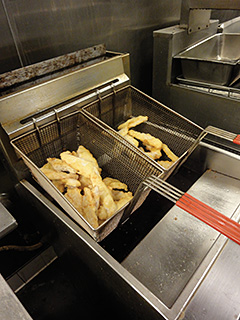 Perhaps, you hope to spot a movie star, shop along Rodeo Drive, or surf in Malibu. Then again, how about a chance to fry up several hundred pounds of frozen pollock?
Perhaps, you hope to spot a movie star, shop along Rodeo Drive, or surf in Malibu. Then again, how about a chance to fry up several hundred pounds of frozen pollock?
Drop, count to ninety, drain. Repeat. Over and over, submerging mesh baskets into sizzling vats of vegetable shortening, until I’d produced a small mountain of golden, crispy fish. This was how I spent a morning in March of 2014, when helping cook lunch at The Midnight Mission, which is the largest, continuously-operating social service agency and homeless shelter in Los Angeles.
I was given the briefest of instructions on how to operate a Hobart Vulcan deep fryer by Rob Rice, who is executive chef in the Midnight Mission’s kitchen, where every day an average crowd of a thousand hungry people arrive for breakfast, lunch and dinner. (This adds up to nearly 100,000 meals a month, or over a million annually.) Once I’d gotten acquainted with the Vulcan, Rice flattened a few empty cardboard boxes onto the floor to absorb splatters of grease which erupted every time fish filets met hot oil. Printed on each box was advertising copy that in bright red lettering proclaimed the pollock to be “Beer-Battered!” The same might be said, I realized, for many of the homeless men and women who’d soon arrive to eat it.
As the hours passed—drop, count to ninety, drain—I chatted with a few of my fellow kitchen workers. Most of them are enrolled in drug and alcohol rehabilitation programs run at the mission, and live with 250 other men in dormitory rooms on the building’s second floor. In a typical greeting, each man would tell me his name, recite how long he’d “used,” then proudly announce the duration of his sobriety.
Noe, who appeared in his late 30’s, was addicted to speed for most of his life, but sober for seven months. He wanted me to know he was adopted from an orphanage in India, by a single woman who lived in Beverly Hills. Hyperactive as a child, Noe was put on Ritalin in the second grade. “Was I born an addict, or was this learned behavior?” he asked me.
Before I could answer, I was shaking hands with Alex, who’d smoked crack cocaine for 35 years, but was 18 months clean. “I fell into fear,” was his harrowingly simple explanation for a decades-long drug habit.
These guys clearly respect Rob Rice, who oversees all meals, but is primarily responsible for food served to the 250 residents, as well as sixty people who are paid, full-time staff members of the Midnight Mission.
A lean, attractive 42-year-old, Rice is a marathon runner who teaches yoga on the weekends. In the past, he was a “Corporate Culinary Trainer” for Wolfgang Puck, training chefs for jobs in Puck’s restaurants such as Spago, Chinois and Postrio. Rice liked to surprise new hires with a “grocery bag test.” The chef was handed a sack full of unlikely items—maybe sardines, Kiwi, and chocolate—and told to make something as tasty as possible in the next 90 minutes.
Was I born an addict, or was this learned behavior?” he asked me.
“Rarely was anything created you’d call inspired, but even being able to make something edible under pressure like that told me something,” Rice said.
He also consulted with the actor, Mark Wahlberg, and his brothers, Donnie and Paul, as they opened a chain of “gourmet burger” restaurants called Wahlburgers. Rice’s career has had its share of ups, downs, and surprising twists of fate, which makes him sensitive to attitudes he occasionally sees among privileged volunteers who drop by the Midnight Mission.
“Sometimes they’ll turn up their noses, and say, ‘Well, the people who end up here have made a series of bad choices.’ Really? Let’s take the judgment out of it, shall we? We are all human. Everyone’s capable of good and bad. Some of us were just luckier to get away with more, without getting caught.”
Rice continued, “I like to think I have a pretty good understanding of the human condition. I don’t baby the guys who work here, but sometimes people need a couple of second chances before they can get it right.”
On the day we met, Rice was coaching a few of his workers through a recipe for glazed carrots and chickpeas. He planned to serve this the following day at a special buffet lunch in honor of Persian New Year, or Nowruz. “I should probably add some rose water, but I don’t have a lot of that lying around,” he observed.
 With an expected head count of 2,000 guests, Rice was assembling ingredients for chicken marinated in yogurt and Middle-Eastern spices; rice with saffron, currants, and apricots, and a mixed green salad. As he discussed recipes with Alex, Noe, and a few other guys, Rice offered impromptu lessons on the healthy benefits of turmeric, and ginger root. He explained why poultry’s dark and white meat are different in texture and flavor. And, he taught an easy way to peel shallots: “Blanche ‘em in a little hot water, and the papery skin will just slide off.”
With an expected head count of 2,000 guests, Rice was assembling ingredients for chicken marinated in yogurt and Middle-Eastern spices; rice with saffron, currants, and apricots, and a mixed green salad. As he discussed recipes with Alex, Noe, and a few other guys, Rice offered impromptu lessons on the healthy benefits of turmeric, and ginger root. He explained why poultry’s dark and white meat are different in texture and flavor. And, he taught an easy way to peel shallots: “Blanche ‘em in a little hot water, and the papery skin will just slide off.”
Watching this shallot-peeling tip was a guy whose massive forearms and neck were inked with apocalyptic tattoos. He looked on with wide-eyed awe, as if Rice had done an incredible feat of magic. When I smiled at him, the tattooed guy grinned back, and said, “Hi, I’m Sam. I used to drink a liter of vodka every day, but now I’ve been clean for 64 days!”
Such refinements of cooking technique (rose water?) might seem effete, if not downright ridiculous, in the setting of a soup kitchen, yet Rice is trying to show these men how a real restaurant operates. Thanks to his past career, Rice has connections to dining spots all over Los Angeles; many have hired guys who used to work with him at the Midnight Mission. In Rice’s experience, restaurant work is often a first leg up for people with less-than-perfect criminal records, because kitchens are a meritocracy where knowledge trumps all.
I don’t baby the guys who work here, but sometimes people need a couple of second chances before they can get it right.”
“An executive chef shows up one day, and discovers one of his sous chefs has quit,” Rice explains. “He’ll go into the dishwashing pit, and ask if anyone there knows how to, say, roll ravioli. Some Mexican guy will shout, ‘I do!’ and he’ll be promoted from dishwasher to prep cook, just like that. This happens in kitchens all over L.A., every day. No one cares if you are a felon, or if you’ve been arrested. If you know how to roll ravioli, or French-Cut vegetables, that’s your opportunity to advance.”
Before he can teach these men how to cook, though, Rice must contend with unique health problems they face transitioning from life on the streets. For instance, in advanced cases of Hepatitis “C,” when a person’s liver stops functioning, their skin will take on a sickly hue. “Any time people are light green, that’s not good,” Rice said.
On a happier note, he firmly believes nutritious eating can ease some of the pain these guys feel as they “detox.”
“It’s a little like a conversion, or being ‘born again,’” Rob said. “It is one palette, one salad, at a time.”
Alex, of the 35-year crack-smoking habit, agrees. His cholesterol levels have gone down dramatically since he’s been on Rice’s diet. “Before I came here, my idea of fresh produce was opening a can of creamed corn,” he said. “Rob changed all that.”
In the process, Rice has to be endlessly flexible with his meal-planning. Perhaps as karmic payback for all those “grocery bag tests” he inflicted, Rice now contends with a chaotic food supply at The Midnight Mission: it’s feast one day, F.E.M.A. the next. Those chickpeas in his glazed carrot recipe come from the Federal Emergency Management Agency. “The beans aren’t whole, but cracked into pieces, so they can’t be sold. They’ll end up as a food drop to a refugee camp, or with me.”
The bigger challenge Rice faces this morning, however, is on the “feast” side. As frequently happens, a vegetable grower from California’s central valley has shown up this morning. This one arrived with dozens of wooden pallets, each piled with many crates of green beans. It is not only a massive quantity, but one that’s on the verge of spoiling. Green beans can last up to two weeks after being picked, Rice explains, but he guesses these will begin to grow mold in the next thirty-six hours.
In the space of a few short steps, there was a distinct change in atmosphere, as if I’d passed…through a portal between happiness and misery.
“Most of our clientele? You show them a cucumber and a zucchini, side-by-side, they wouldn’t know the difference. They’ve been raised on fast food, and when I say ‘raised,’ I mean eating at McDonald’s for three meals a day, practically their whole life. If food is not fried and heavy, they won’t touch it. It’s a very big problem, because unless I smother vegetables with cheese sauce, they won’t eat them. Not to mention, a lot of them don’t have many teeth left, so it’s hard for them to chew.”
Rice and I stared at the many pallets of green beans, stacked from floor to ceiling. It would require an ocean of cheese sauce to smother all of these.
The Midnight Mission is located in a part of Los Angeles tourists rarely see. I’ve probably been to Los Angeles fifty times in my life, but never ventured to these blocks just a short walk from the Staples Center, L.A.’s enormous sports and entertainment complex. This downtown district, which was nearly a ghost town for several decades, is currently enjoying a Renaissance, with elegantly-faded office buildings and boarded-up movie palaces from Hollywood’s heyday in the 1920’s and 30’s being refurbished and given new life. I felt happy and excited to be there, with a real sense of discovery.
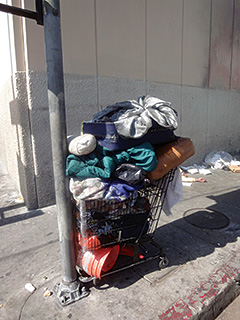 My merry mood, however, changed immediately as I headed east on Sixth, and crossed over Los Angeles Street. In the space of a few short steps, there was a distinct change in atmosphere, as if I’d passed over an invisible line dividing affluence and poverty, or through a portal between happiness and misery. Civic boosters and real estate brokers may have dubbed this neighborhood as Central City East, but everyone else calls it “Skid Row.”
My merry mood, however, changed immediately as I headed east on Sixth, and crossed over Los Angeles Street. In the space of a few short steps, there was a distinct change in atmosphere, as if I’d passed over an invisible line dividing affluence and poverty, or through a portal between happiness and misery. Civic boosters and real estate brokers may have dubbed this neighborhood as Central City East, but everyone else calls it “Skid Row.”
The term dates back to the 17th century, when it referred to a muddy passageway through the woods along which felled timber was hauled. This artery, especially at its shore-line terminus, was the Broadway (or “main drag”) of a logging camp; most of the bars and brothels patronized by men working in such camps were built nearby. Functioning both as a latrine and boxing ring, inevitably blood, vomit, urine and shit would mix into the mud of Skid Row. By the end of the 19th century, the name was used for any locale—from San Francisco’s Tenderloin District, to the Bowery in Lower Manhattan—where men who were down on their luck would gather.
Today, Los Angeles contains the largest population of homeless people in the United States, an estimated 58,000 people. As a result, quite a lot of downtown is nearly impassable, so congested are its sidewalks with overloaded shopping carts, garbage bags full of who-knows-what, and mysterious bundles tied with rope. There’s laundry hung to dry on chain link fences, as well as buzzing swarms of flies drawn to the dirt and decay. All is jumbled and tumbled together, as if there’s been an earthquake, or terrible fire, and thousands of people have been unexpectedly dislocated, forced to grab whatever they could, and camp here, in the open.
Flimsy and improvised as things at first appear, a closer look shows these living situations to be more or less permanent installations. Pieces of blown-out furniture (sofas, chairs, dining tables, bureaus), force pedestrians to walk in the street. Inside these outdoor “rooms,” people hang out, sprawled across filthy mattresses, sitting on plastic lawn chairs, or on upturned buckets that once held sheetrock compound. They are smoking and drinking beer; talking, laughing or dozing. This vista, of strangely relaxed despair, stretches for many blocks in all directions around The Midnight Mission, which was founded in 1914.
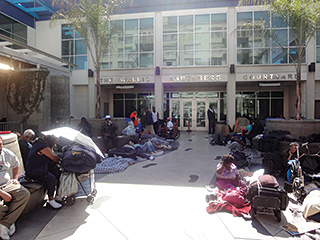 “For nearly a century, we’ve been a beacon of light for those with no where else to turn,” said Ryan Navales, the mission’s Public Affairs Coordinator, who gave me a tour around the facility on my first morning there. “Downtown Los Angeles has long been a magnet for drifters, and people hoping for a lucky break. There’s been this persistent idea it might happen if they came west. Families drifted out here during the Great Depression. Farmers came when they were fleeing the Dust Bowl. Veterans poured in following World War I and II, Vietnam, and now Iraq and Afghanistan.”
“For nearly a century, we’ve been a beacon of light for those with no where else to turn,” said Ryan Navales, the mission’s Public Affairs Coordinator, who gave me a tour around the facility on my first morning there. “Downtown Los Angeles has long been a magnet for drifters, and people hoping for a lucky break. There’s been this persistent idea it might happen if they came west. Families drifted out here during the Great Depression. Farmers came when they were fleeing the Dust Bowl. Veterans poured in following World War I and II, Vietnam, and now Iraq and Afghanistan.”
A third of the homeless in Los Angeles have substance abuse problems, Navales estimated. “At Midnight Mission, our focus is on them. Booze is a bigger problem than drugs. It’s cheaper, and legal, so it’s much easier to get.” He then quickly corrected himself. “We shouldn’t talk about the homeless as if they are all the same. ‘Homeless’ is an adjective, not a noun. It’s a homeless man, a homeless woman, or a homeless child. There are 58,000 homeless individuals in Los Angeles, and 58,000 different stories of how they ended up this way.” (To put this number in context, Navales tells me 58,000 people would be a near-capacity crowd at the Los Angeles Dodgers’ baseball park.)
Navales then shared his story. He comes from a small town called Pilgrim, in the Eastern High Sierra in Northern California. Though he made his living as a carpenter, he was also a “Microsoft-trained tech engineer,” with a three-bedroom house in Pasadena. But he developed a taste for alcohol, and soon graduated to heroin. “I had run amok, and was living on the streets. My family, and my parents, all reached their limits with me. I burned every bridge possible.”
For nearly a century, we’ve been a beacon of light for those with no where else to turn.”
Three years ago, a cousin dropped him off at the Midnight Mission; all that was left of his life was in one backpack. Fifty pounds heavier than he is now, Navales said it was even hard for him to walk, as he could only shuffle his feet along like an old man. “I was swollen up like a tick from all the alcohol in my system. I had a distended liver. I was pissing blood, and addicted to librium.”
He paused, his eyes having welled-up; Navales took a few deep breaths before continuing. “I recognized this might be my last chance. I grabbed on to what was available here, and I got busy getting sober. This place saved my ass. My life now is smaller than before, but it’s manageable.”
During our time together, Navales emphasized three things.
First, the Midnight Mission does not take any government money, but is completely funded by the donations of individuals, families and corporations. Lately, some of the biggest financial contributors are wealthy Iranians who live in the Pacific Palisades.
“They wanted to give back to the community, but there really aren’t many homeless or needy people in their neighborhood,” Navales explains, allowing himself a small grin at this understatement. (Pacific Palisades is one of the most affluent areas in the United States.) “So, three years ago, they decided to hold a Nowruz celebration here at the mission. We cook up traditional Persian food, and we close down Sixth Street, and set up tables for an open-air buffet. You’ll see what it’s like tomorrow; it’s really great!”
We are not a soup kitchen,” Adamson told me, his voice impatient. “We don’t serve soup. I want to banish that stereotype.”
Second, the mission is one of America’s largest organizers of 12-step meetings for the homeless. In the three days I spent there, I was frequently asked if I’m in the “program,” or if I am a “friend of Bill’s.” They were not inquiring about my kinship with former U.S. President Bill Clinton, but Bill. W., the founder of Alcoholics Anonymous.
Finally, the Midnight Mission is both non-sectarian, and non-religious. “There is no praying here, and no church,” Navales said. “You don’t have to do anything to get help, except ask for it.”
This last point is something of an irony, given the Midnight Mission’s founder, Tom Liddecoat, was famously religious and a firm believer in the power of prayer.
I learned some of this history from Larry Adamson, who is president and CEO of the Midnight Mission, and only the fourth director in its 100 year history. As an ice-breaker when we first met in his office, I asked how it felt to run America’s largest soup kitchen. This proved an unfortunate blunder.
“We are not a soup kitchen,” Adamson told me, his voice impatient. “We don’t serve soup. I want to banish that stereotype. Our executive chef, Rob Rice, used to work for Wolfgang Puck, so we have some very well-fed homeless people, trust me.”
What’s more, because of many donations of fresh food, Adamson estimated the average cost of these excellent meals served at The Midnight Mission is less than 14 cents each. (Later, Rob Rice will claim it is closer to 11 cents.) “But, the unexpected arrival of food each day puts major demands on Rob,” Adamson explains. “When a truck load of broccoli shows up, he has to quickly decide what to do with it.”
I think of all those about-to-go-moldy green beans.
“Which, in a funny way, brings us back to our creation a century ago,” Adamson said.
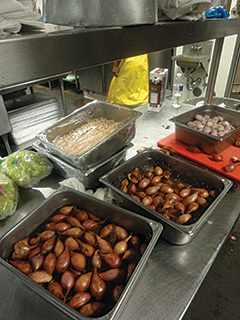 Thomas Liddecoat, or “Brother Tom,” was a broker for fruits and vegetables, who sold these perishable goods (this was before refrigeration was readily available) to “Mom and Pop” grocery stores operating along Main Street and Los Angeles Streets, two avenues that defined downtown L.A. at the beginning of the 20th century. In those years, the city’s population was growing rapidly, as was its homeless population. When Liddecoat saw how many WWI veterans, and other vagrants who were living on the edges of downtown, hungry and hopeless, he suddenly had an idea. After work, he could go back to his customers and retrieve whatever food they felt was about to spoil, and would soon throw out. Liddecoat brought this back to his house, where his wife, Mary, and he would cook it up, and serve it to homeless men—but only after they’d listened to one of Liddecoat’s sermons.
Thomas Liddecoat, or “Brother Tom,” was a broker for fruits and vegetables, who sold these perishable goods (this was before refrigeration was readily available) to “Mom and Pop” grocery stores operating along Main Street and Los Angeles Streets, two avenues that defined downtown L.A. at the beginning of the 20th century. In those years, the city’s population was growing rapidly, as was its homeless population. When Liddecoat saw how many WWI veterans, and other vagrants who were living on the edges of downtown, hungry and hopeless, he suddenly had an idea. After work, he could go back to his customers and retrieve whatever food they felt was about to spoil, and would soon throw out. Liddecoat brought this back to his house, where his wife, Mary, and he would cook it up, and serve it to homeless men—but only after they’d listened to one of Liddecoat’s sermons.
“Liddecoat was a lay preacher, of the Pentecostal faith,” Adamson recounted. “He was said to deliver a very fiery message! Not only heated, his talks were lengthy, too. By the time a meal was finally served it was usually quite late at night. Legend has it, then, people would say of Liddecoat’s operation, ‘Oh, that’s the place where you can go get dinner at midnight!’ Hoboes began to refer to the place as the ‘midnight mission’ and the name stuck.”
Intrigued by what Adamson told me, I did some more research about Liddecoat. Early accounts of his life are vague, and frequently a bit contradictory. Liddecoat eventually become quite a celebrity, and conducted many newspaper interviews. Whether because of unscrupulous journalists, or Liddecoat’s own burnishing of his past, certain stories about him which may or may not be true nonetheless became established facts over time.
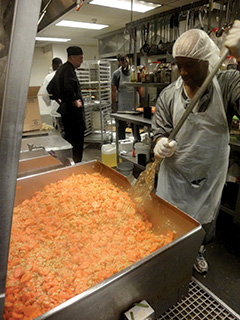 Born in 1864 in England, Liddecoat immigrated to the United States, and ended up in Colorado, he said, because his father caught “gold fever.” Later in life, Liddecoat was often quoted as saying he spent his teenage years being raised by American Indians, witnessed the Wounded Knee massacre of Lakota Indians in 1890, rode with Buffalo Bill, and wild venison was his favorite meat dish. He usually completed this portion of his biography by telling of a promise he made to God. In several printed stories, Liddecoat is quoted with words that are nearly identical: “One night, when the moon and stars were shining brightly, I rode on my horse to a secluded spot and promised God I would be His worker if He would let me prosper.”
Born in 1864 in England, Liddecoat immigrated to the United States, and ended up in Colorado, he said, because his father caught “gold fever.” Later in life, Liddecoat was often quoted as saying he spent his teenage years being raised by American Indians, witnessed the Wounded Knee massacre of Lakota Indians in 1890, rode with Buffalo Bill, and wild venison was his favorite meat dish. He usually completed this portion of his biography by telling of a promise he made to God. In several printed stories, Liddecoat is quoted with words that are nearly identical: “One night, when the moon and stars were shining brightly, I rode on my horse to a secluded spot and promised God I would be His worker if He would let me prosper.”
At the turn of the century, after launching a successful business of selling fruit and produce in Colorado, Liddecoat came to Los Angeles, where he expanded into a wholesale operation. Apparently God saw fit to answer Liddecoat’s horseback prayer; by the time he opened a shelter for the homeless in 1917, situated at what he called “Hell’s Half Acre” on Los Angeles Street, Liddecoat was able to pay for it with $100,000 of his own money.
Soon, he was known for carrying around specially-printed tickets in his pocket, that he would pass out to homeless people. It promised, free of charge, “one meal, bath, bed, barber, laundry, doctor visit … and salvation!” Though listed first on this ticket, in those early days, meals were pretty much an afterthought, and prepared in ways that were haphazard, at best. Food at the mission was exposed to flies and cockroaches, as well as being handled by men who were afflicted with a variety of diseases, including syphilis and tuberculosis.
“Beggars can’t be choosers,” Brother Tom often replied when people complained about such unsanitary conditions.
When, in 1929, the Los Angeles health department and other city agencies forced the Midnight Mission to “clean up or close up,” Brother Tom was unbowed and only grudgingly put more sanitary practices into his operation. He argued if city government couldn’t be bothered to make any other provision for these men, it was hypocritical for such charges to be levied against his kitchen. Above all, Liddecoat did not want his men to feel coddled. On the contrary, he called them “jailbirds, hopheads and drunkards” to their faces, and insisted they were wholly accountable for all the bad decisions they’d made. He also never failed to remind his listeners of how much worse off they’d be without him.
If a man has food, lodging and a presentable exterior, he will not turn to crime.”
Despite, or maybe because of such tough love, the number of people showing up at the Midnight Mission continued to grow, and soon exceeded Liddecoat’s ability to pay for it himself. Seeking out deep-pocketed donors, among his earliest supporters were Harry Chandler, publisher of The Los Angeles Times, and Albert M. Johnson, an eccentric millionaire who was President of the National Life Insurance Company. Liddecoat frequently stepped into the pulpit on Sunday mornings at various L.A. churches, including Sister Aimee McPherson’s Church of the Foursquare Gospel. Being hailed as the savior of the unwanted by community leaders, he also took his show on the road as a chaplain for the United Fruit and Vegetable Association, raising awareness of the homelessness problem at produce conventions nationwide. “No man is safe and no citizen’s property is secure so long as any man is either hungry or unemployed,” he liked to say. “If a man has food, lodging and a presentable exterior, he will not turn to crime.”
As Liddecoat’s fame grew, he traveled widely across the United States, and even internationally, for the next three decades— often accompanied by his daughter, Mary. He seldom turned down a request for a photograph or interview and, with his well-rehearsed skill for telling heart-rending stories about the men of Hell’s Half-Acre, Liddecoat was always “good copy.” Appreciative members of the press returned the favor by bestowing upon him such grandiose nicknames as the “Bishop of the Underworld” and “Father of the Poor,” while the L.A. Realty Board dubbed him “the most useful citizen in L.A.”
Brother Tom Liddecoat died in 1942.
Rob Rice was looking glum. He stared at half a dozen stainless steel bins full of what appeared to be pink wads of already-chewed bubble gum, but was actually mechanically-separated chicken, or MSC. Like the broken chickpeas, MSC is F.E.M.A. food.
“I wish I didn’t have to use it, but we regularly get thousands of pounds donated to us. I can’t afford to buy anything else, so it’s actually our biggest source of protein.”
This crowd will not eat dal. They want the chili.”
Rice spends a surprising amount of his food budget on flavorings to make this pink goop palatable. Each week, he uses ten pounds of coarse-ground black pepper, a similar amount of curry powder, oregano, and parsley, as well as 30 pounds of peeled garlic cloves. Listing all of this, lead him into an embittered rant on why MSC is “damn near toxic.”
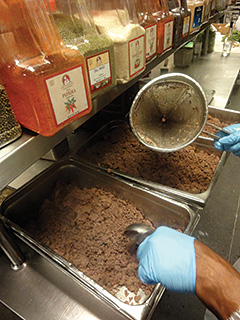 Prior to the mid-20th century, he explained, a lot of meat scraps and tissue from cows, pigs, chickens, and turkeys went to waste because processors had no efficient means of separating it from animal carcasses after the bulk of their meat was removed. Machines developed in the 1960s automated the process, however, which made this salvage of scraps faster and cheaper. Today, what remains of a picked-clean carcass is ground up, combining bone, bone marrow, skin, nerves, and blood vessels in addition to a miniscule amount of actual meat. What results is a substance with the consistency of cake batter, which can then be formed into meat “by-products” such as chicken nuggets, bologna, or hot dogs.
Prior to the mid-20th century, he explained, a lot of meat scraps and tissue from cows, pigs, chickens, and turkeys went to waste because processors had no efficient means of separating it from animal carcasses after the bulk of their meat was removed. Machines developed in the 1960s automated the process, however, which made this salvage of scraps faster and cheaper. Today, what remains of a picked-clean carcass is ground up, combining bone, bone marrow, skin, nerves, and blood vessels in addition to a miniscule amount of actual meat. What results is a substance with the consistency of cake batter, which can then be formed into meat “by-products” such as chicken nuggets, bologna, or hot dogs.
Before he can put it into spaghetti, chili or curry, Rice boils the MSC, then strains it to remove most of the excess fat. At his urging, I reluctantly reached into a pan of cooked chicken and put a teaspoon or so into my mouth. I was prepared for it to taste bad; to my surprise, though, it had little or no flavor whatsover. It was like chewing a bunch of rubber bands.
“I wish I could change the way people eat,” he said, “but these guys are very aware of their stomachs’ real estate. From 8 p.m, to 8 a.m., there is no food to be found in the mission. You and I are accustomed to going this long without eating. When so much is out of their control, though, and they’re trying to impose so many rules on themselves they’ve never known before, to have nothing to eat for that amount of time seems scary. They’d rather fill up on chili and cheese, because they think this will tide them over longer, and give them more energy.”
“A big bowl of dal [Indian lentils] and rice would taste better, fill them up more, be healthier, and cheaper to produce than chili made with mechanically-separated chicken,” he said. “But this crowd will not eat dal. They want the chili.”
Rice’s posture, normally so upright, had momentarily collapsed. His shoulders, and the corners of his mouth, were sagging downward.
“This place is dark. It demands a lot. A lot of people who come here suffer from mental illness, or have been the victims of really quite extreme abuse. I think the whole first month I worked here, I would go home crying practically every night.
“But you have to make a distinction between those who are lost, and those who are wandering,” Rice said. “If they’re lost, all you can do is show them unconditional love, and treat them as nicely as you can. For the wandering, though, it’s about letting them experience success once in a while.”
At this last thought, his mood brightened. Soon enough, he was again giving directions and orders to his kitchen staff. Owing to their limited attention spans, he’s learned it is best to assign each guy with one simple task at a time. This included me. Yesterday, I’d spent hours deep-frying pollock; now I was told to peel and dice Bermuda Onions. I worked at this for several hours, by which point I’d long since stopped weeping from the onion fumes, and could finish the job dry-eyed.
The Nowruz lunch was about to begin. There were probably 100 men and women standing just outside the kitchen, all wearing gaily colored T-shirts which announced, “Nowruz—The 2014 Iranian New Year’s Festival.”
 A local bakery had donated several hundred lemon meringue pies. Each pie needed to be cut into eight pieces; each individual slice then put on to a plate. Rice demonstrated his preferred technique, severing the pie clean in half, then into quadrants, then eighths.
A local bakery had donated several hundred lemon meringue pies. Each pie needed to be cut into eight pieces; each individual slice then put on to a plate. Rice demonstrated his preferred technique, severing the pie clean in half, then into quadrants, then eighths.
“Got it?” he asked.
“Got it,” I replied.
When I tried to communicate this method to a few of the Iranian women, however, the lesson didn’t go over too well. Either these ladies are perpetually on gluten-free diets, or they have chefs at their houses in the Pacific Palisades who do pie-cutting for them. For whatever reason, the prospect of making individual servings of all these pies was met with raised eyebrows and much clucking of tongues.
“They’ve got it under control,” Rice said, as he pulled me by the elbow. He wanted me to accompany him out to the loading dock of Midnight Mission to see something I might find surprising.
I think the whole first month I worked here, I would go home crying practically every night.”
As we walked there, he paused to inspect a delivery of cauliflower “cores.” At some distant vegetable processing plant, there is a machine which plunges a circular blade into the underside of a head of cauliflower. This apparatus, something like a hole punch, shears off all the florets, and what’s left behind is a central stalk about the size of a soda can. Crate after crate, containing hundreds (if not thousands) of these cores now awaited Rice’s attention.
“What’s most odd about this, of course, is that up to 70-percent of all the nutrients in cauliflower is found in its stalk,” he said.
The cauliflower was not the “surprise,” though. Instead, it’s still more pallets of food just arrived from L.A. Specialty, which is The Midnight Mission’s single largest donor of food. What’s come this morning is an astounding bounty of organic produce such as broccoli, snap peas, romaine lettuce, arugula, sweet peppers, fava beans, avocados, and portobello mushrooms.
“If I had a restaurant, and you sent me this, I’d have a menu for the next few nights,” Rice said.
L.A. Speciality is one of Southern California’s most esteemed purveyors of fresh fruits and produce. All the city’s finest restaurants order from them, and most of these customers have an arrangement whereby rather than throw away what they haven’t used, L.A. Specialty trucks will haul it away and bring it over to The Midnight Mission. As such, 100 years after Tom Liddecoat got the idea to cook meals from produce his customers didn’t sell, the same strategy is still at work. I can’t decide if this is wonderful, or awful.
There’s no time to ponder this, though, as Rice needs me to get busy on cutting carrots. A couple of other guys were washing and peeling them, while I was to work my way through tub after tub, slicing away. Rice ordered me to make a “French cut,” by holding the knife at a 45 degree angle so it sliced the carrot diagonally into an oval shape. The greater surface area on each oval slice, he said, would increase the amount of its natural sugars that caramelized as it was stir-fried. This was news to me.
I realized Rice was giving me a second chance.
After cutting for an hour or so, my wrists began to tingle a bit, then ache. My knife was starting to get dull. I didn’t know where a sharpening steel might be; I wasn’t even sure this kitchen had one. Because of a blunt blade, and my somewhat dulled wits, holding the knife at a 45-degree angle began to be rather a lot of work. Gradually, I shifted the knife upwards, and began to slice perpendicularly. This was much easier. I kept at it, slicing and slicing, with carrots and the color orange filling my vision. My mind wandering, I’d lost track of time, when I suddenly noticed Rice was standing at my side.
He picked up a carrot slice, which was perfectly round, not oval.
“What happened to my French Cut?”
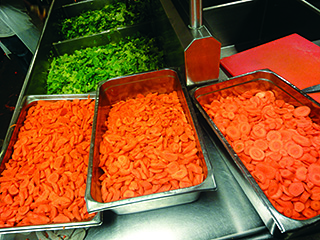 I was about to complain about the numbing repetition of this task. Wasn’t there something more important for me to be doing? But, I thought better of it. What if I were down on my luck, in detox from many years of drug abuse, and this skill Rob was trying to teach me might be the very thing which could get me a job, and escape from Skid Row?
I was about to complain about the numbing repetition of this task. Wasn’t there something more important for me to be doing? But, I thought better of it. What if I were down on my luck, in detox from many years of drug abuse, and this skill Rob was trying to teach me might be the very thing which could get me a job, and escape from Skid Row?
“I’m sorry, Rob,” I said.
He didn’t smile and say, “Oh, that’s O.K.” Instead, he glared at me for a few long seconds and, just before walking away, repeated his earlier instructions. “Keep the knife at a 45 degree angle, OK?”
I realized Rice was giving me a second chance. Whether or not I would use this as an opportunity to experience success was completely up to me.



